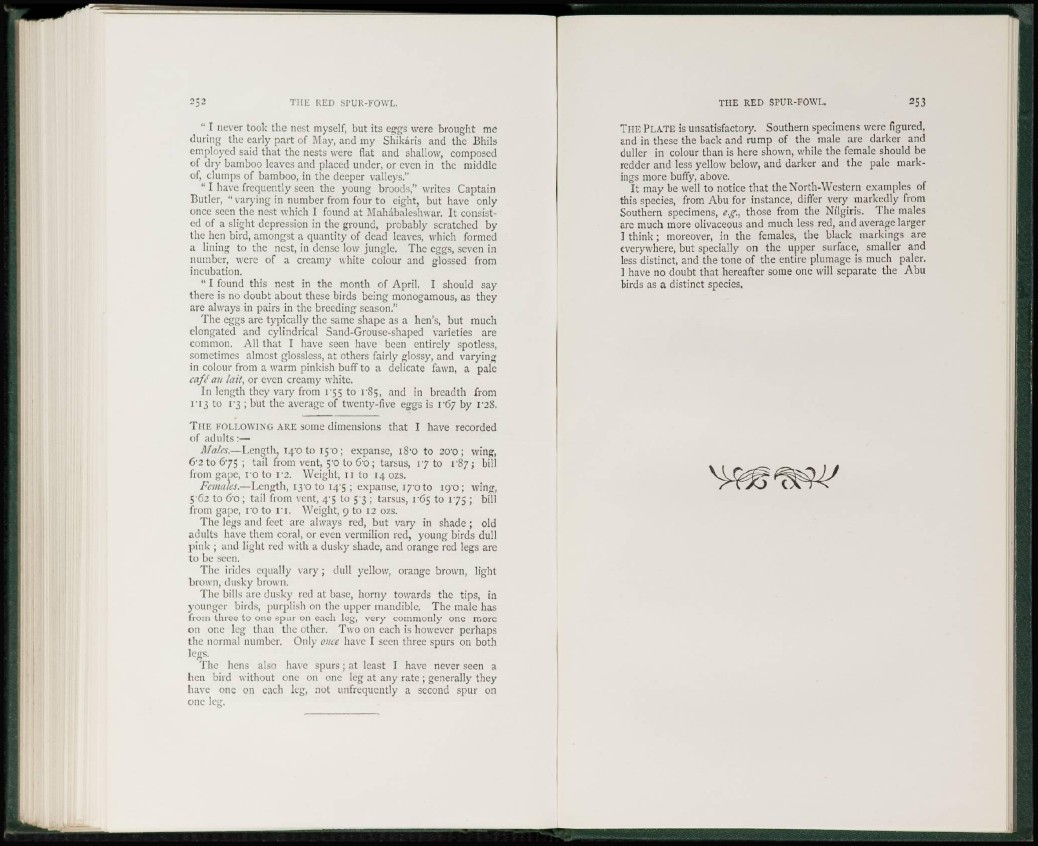
" I never took the nest myself, but its eggs were brought me
during the early part of May, and my Shikaris and the Bhils
employed said that the nests were flat and shallow, composed
of dry bamboo leaves and placed under, or even in the middle
of, clumps of bamboo, in the deeper valleys."
" I have frequently seen the young broods," writes Captain
Butler, " varying in number from four to eight, but have only
once seen the nest which I found at Mahabaleshwar. It consisted
of a slight depression in the ground, probably scratched by
the hen bird, amongst a quantity of dead leaves, which formed
a lining to the nest, in dense low jungle. The eggs, seven in
number, were of a creamy white colour and glossed from
incubation.
" I found this nest in the month of April. I should say
there is no doubt about these birds being monogamous, as they
arc always in pairs in the breeding season."
The eggs are typically the same shape as a hen's, but much
elongated and cylindrical Sand-Grouse-shaped varieties are
common. All that I have seen have been entirely spotless,
sometimes almost glossless, at others fairly glossy, and varying
in colour from a warm pinkish buff to a delicate fawn, a pale
cafe" an /ait, or even creamy white.
In length they vary from I '55 to r§5, and in breadth from
1*13 to 1-3 ; but the average of twenty-five eggs is l'6y by V2S.
T H E FOLLOWING ARE some dimensions that I have recorded
of adults :—
Males.—Length, 14/0 to 150; expanse, iS'O to 20x5; wing,
62 to 675 ; tail from vent, 5'0 to 6x>; tarsus, 17 to 187; bib
from gape, 1 0 to i"2. Weight, 11 to 14 ozs.
Females.—Length, i3-o to I4'5 ; expanse, 17'Oto 19/0 ; wing,
562 to 60 ; tail from vent, 4'5 to 53 ; tarsus, 165 to 175 ; bill
from gape, 10 to I' l . Weight, 9 to 12 ozs.
The legs and feet are always red, but vary in shade ; old
adults have them coral, or even vermilion red, young birds dull
pink ; and light red with a dusky shade, and orange red legs are
to be seen.
The irides equally vary ; dull yellow, orange brown, light
brown, dusky brown.
The bills are dusky red at base, horny towards the tips, in
younger birds, purplish on the upper mandible. The male has
from three to one spur on each leg, very commonly one more
on on.e leg than the other. Two on each is however perhaps
the normal number. Only once have I seen three spurs on both
legs.
The hens also have spurs; at least I have never seen a
hen bird without one on one leg at any rate ; generally they
have one on each leg, not unfrequently a second spur on
one leg.
THE PLATE is unsatisfactory. Southern specimens were figured,
and in these the back and rump of the male are darker and
duller in colour than is here shown, while the female should be
redder and less yellow below, and darker and the pale markings
more buffy, above.
It may be well to notice that the North-Western examples of
this species, from Abu for instance, differ very markedly from
Southern specimens, e.g., those from the Nflgiris. The males
are much more olivaceous and much less red, and average larger
I think; moreover, in the females, the biack markings are
everywhere, but specially on the upper surface, smaller and
less distinct, and the tone of the entire plumage is much paler.
I have no doubt that hereafter some one will separate the Abu
birds as a distinct species.